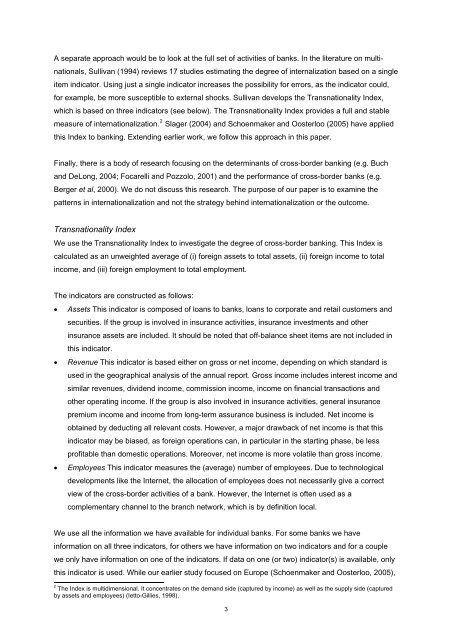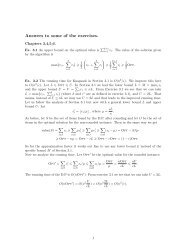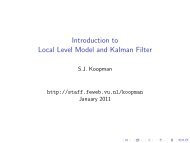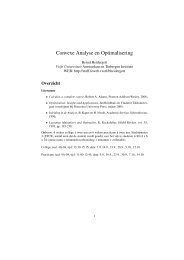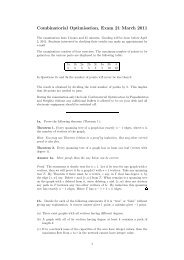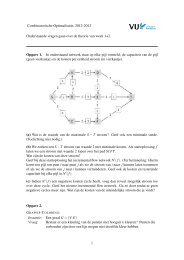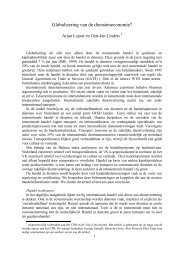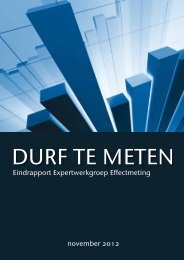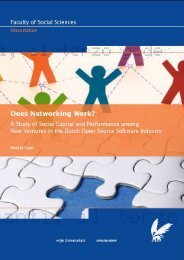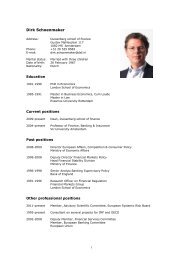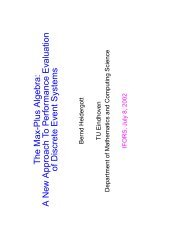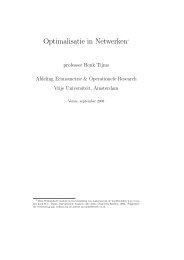Current State of Cross-Border Banking - Vrije Universiteit Amsterdam
Current State of Cross-Border Banking - Vrije Universiteit Amsterdam
Current State of Cross-Border Banking - Vrije Universiteit Amsterdam
Create successful ePaper yourself
Turn your PDF publications into a flip-book with our unique Google optimized e-Paper software.
A separate approach would be to look at the full set <strong>of</strong> activities <strong>of</strong> banks. In the literature on multi-<br />
nationals, Sullivan (1994) reviews 17 studies estimating the degree <strong>of</strong> internalization based on a single<br />
item indicator. Using just a single indicator increases the possibility for errors, as the indicator could,<br />
for example, be more susceptible to external shocks. Sullivan develops the Transnationality Index,<br />
which is based on three indicators (see below). The Transnationality Index provides a full and stable<br />
measure <strong>of</strong> internationalization. 2 Slager (2004) and Schoenmaker and Oosterloo (2005) have applied<br />
this Index to banking. Extending earlier work, we follow this approach in this paper.<br />
Finally, there is a body <strong>of</strong> research focusing on the determinants <strong>of</strong> cross-border banking (e.g. Buch<br />
and DeLong, 2004; Focarelli and Pozzolo, 2001) and the performance <strong>of</strong> cross-border banks (e.g.<br />
Berger et al, 2000). We do not discuss this research. The purpose <strong>of</strong> our paper is to examine the<br />
patterns in internationalization and not the strategy behind internationalization or the outcome.<br />
Transnationality Index<br />
We use the Transnationality Index to investigate the degree <strong>of</strong> cross-border banking. This Index is<br />
calculated as an unweighted average <strong>of</strong> (i) foreign assets to total assets, (ii) foreign income to total<br />
income, and (iii) foreign employment to total employment.<br />
The indicators are constructed as follows:<br />
• Assets This indicator is composed <strong>of</strong> loans to banks, loans to corporate and retail customers and<br />
securities. If the group is involved in insurance activities, insurance investments and other<br />
insurance assets are included. It should be noted that <strong>of</strong>f-balance sheet items are not included in<br />
this indicator.<br />
• Revenue This indicator is based either on gross or net income, depending on which standard is<br />
used in the geographical analysis <strong>of</strong> the annual report. Gross income includes interest income and<br />
similar revenues, dividend income, commission income, income on financial transactions and<br />
other operating income. If the group is also involved in insurance activities, general insurance<br />
premium income and income from long-term assurance business is included. Net income is<br />
obtained by deducting all relevant costs. However, a major drawback <strong>of</strong> net income is that this<br />
indicator may be biased, as foreign operations can, in particular in the starting phase, be less<br />
pr<strong>of</strong>itable than domestic operations. Moreover, net income is more volatile than gross income.<br />
• Employees This indicator measures the (average) number <strong>of</strong> employees. Due to technological<br />
developments like the Internet, the allocation <strong>of</strong> employees does not necessarily give a correct<br />
view <strong>of</strong> the cross-border activities <strong>of</strong> a bank. However, the Internet is <strong>of</strong>ten used as a<br />
complementary channel to the branch network, which is by definition local.<br />
We use all the information we have available for individual banks. For some banks we have<br />
information on all three indicators, for others we have information on two indicators and for a couple<br />
we only have information on one <strong>of</strong> the indicators. If data on one (or two) indicator(s) is available, only<br />
this indicator is used. While our earlier study focused on Europe (Schoenmaker and Oosterloo, 2005),<br />
2<br />
The Index is multidimensional. It concentrates on the demand side (captured by income) as well as the supply side (captured<br />
by assets and employees) (Ietto-Gillies, 1998).<br />
3


